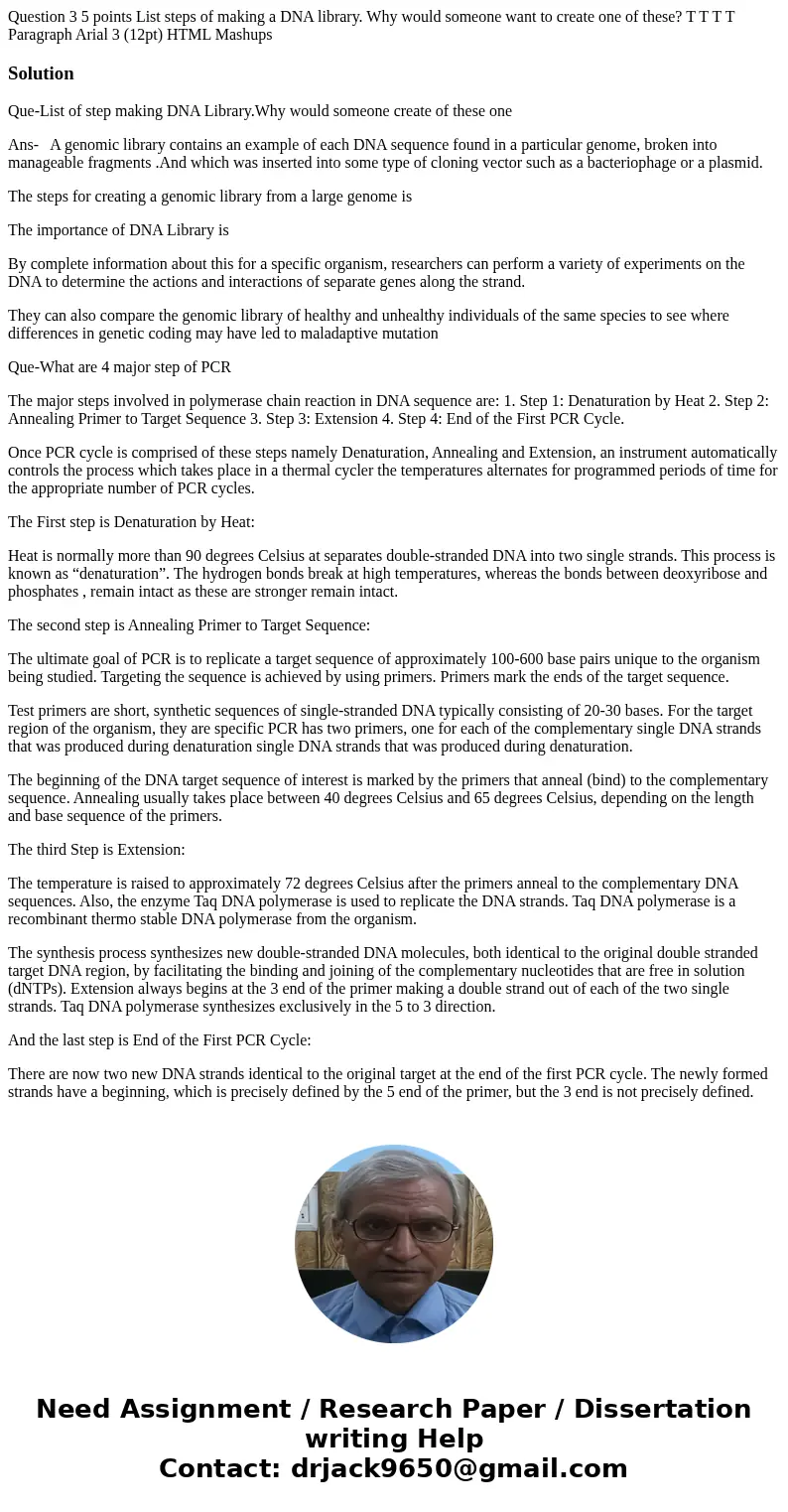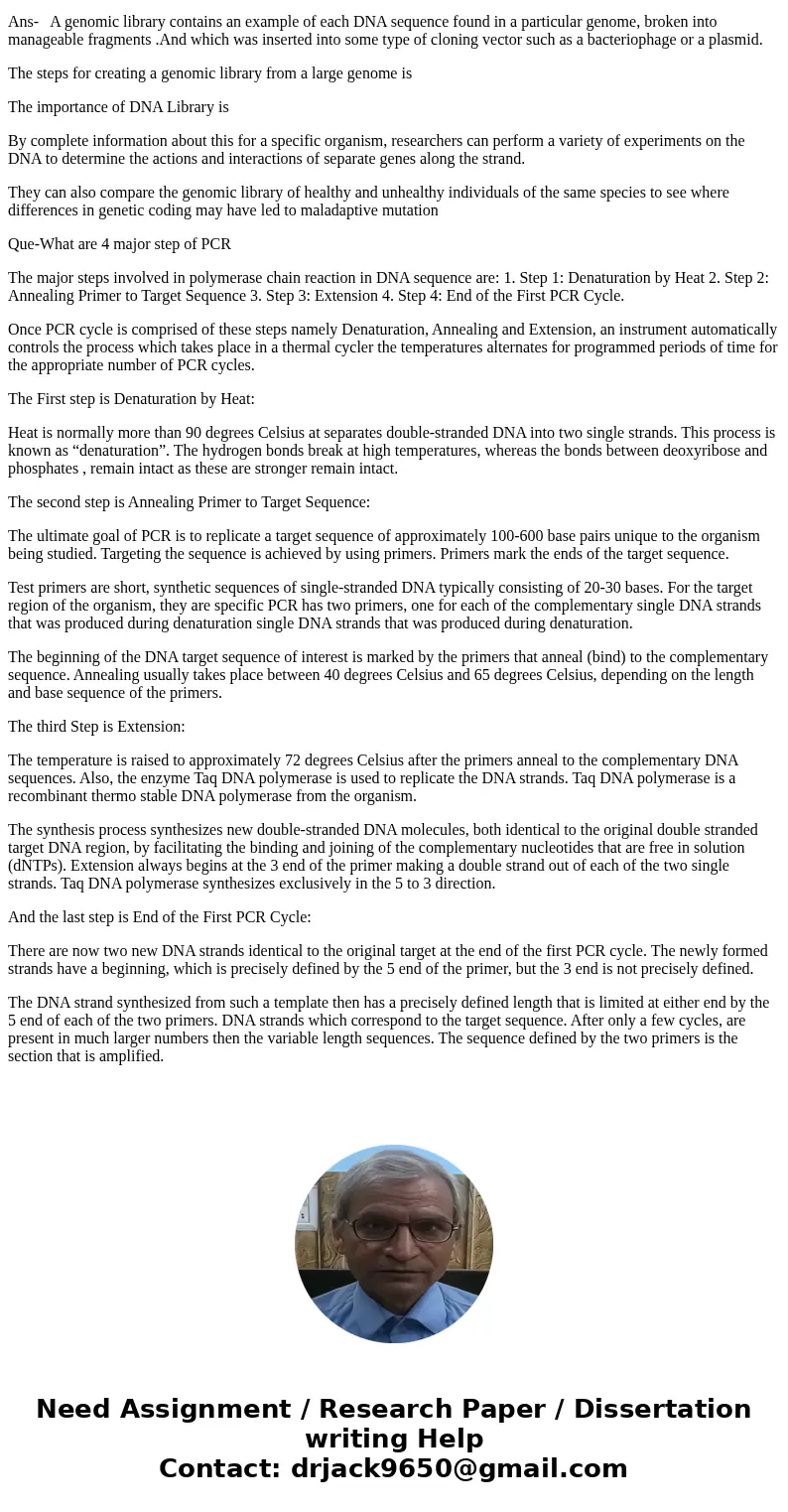Question 3 5 points List steps of making a DNA library Why w
Solution
Que-List of step making DNA Library.Why would someone create of these one
Ans- A genomic library contains an example of each DNA sequence found in a particular genome, broken into manageable fragments .And which was inserted into some type of cloning vector such as a bacteriophage or a plasmid.
The steps for creating a genomic library from a large genome is
The importance of DNA Library is
By complete information about this for a specific organism, researchers can perform a variety of experiments on the DNA to determine the actions and interactions of separate genes along the strand.
They can also compare the genomic library of healthy and unhealthy individuals of the same species to see where differences in genetic coding may have led to maladaptive mutation
Que-What are 4 major step of PCR
The major steps involved in polymerase chain reaction in DNA sequence are: 1. Step 1: Denaturation by Heat 2. Step 2: Annealing Primer to Target Sequence 3. Step 3: Extension 4. Step 4: End of the First PCR Cycle.
Once PCR cycle is comprised of these steps namely Denaturation, Annealing and Extension, an instrument automatically controls the process which takes place in a thermal cycler the temperatures alternates for programmed periods of time for the appropriate number of PCR cycles.
The First step is Denaturation by Heat:
Heat is normally more than 90 degrees Celsius at separates double-stranded DNA into two single strands. This process is known as “denaturation”. The hydrogen bonds break at high temperatures, whereas the bonds between deoxyribose and phosphates , remain intact as these are stronger remain intact.
The second step is Annealing Primer to Target Sequence:
The ultimate goal of PCR is to replicate a target sequence of approximately 100-600 base pairs unique to the organism being studied. Targeting the sequence is achieved by using primers. Primers mark the ends of the target sequence.
Test primers are short, synthetic sequences of single-stranded DNA typically consisting of 20-30 bases. For the target region of the organism, they are specific PCR has two primers, one for each of the complementary single DNA strands that was produced during denaturation single DNA strands that was produced during denaturation.
The beginning of the DNA target sequence of interest is marked by the primers that anneal (bind) to the complementary sequence. Annealing usually takes place between 40 degrees Celsius and 65 degrees Celsius, depending on the length and base sequence of the primers.
The third Step is Extension:
The temperature is raised to approximately 72 degrees Celsius after the primers anneal to the complementary DNA sequences. Also, the enzyme Taq DNA polymerase is used to replicate the DNA strands. Taq DNA polymerase is a recombinant thermo stable DNA polymerase from the organism.
The synthesis process synthesizes new double-stranded DNA molecules, both identical to the original double stranded target DNA region, by facilitating the binding and joining of the complementary nucleotides that are free in solution (dNTPs). Extension always begins at the 3 end of the primer making a double strand out of each of the two single strands. Taq DNA polymerase synthesizes exclusively in the 5 to 3 direction.
And the last step is End of the First PCR Cycle:
There are now two new DNA strands identical to the original target at the end of the first PCR cycle. The newly formed strands have a beginning, which is precisely defined by the 5 end of the primer, but the 3 end is not precisely defined.
The DNA strand synthesized from such a template then has a precisely defined length that is limited at either end by the 5 end of each of the two primers. DNA strands which correspond to the target sequence. After only a few cycles, are present in much larger numbers then the variable length sequences. The sequence defined by the two primers is the section that is amplified.


 Homework Sourse
Homework Sourse